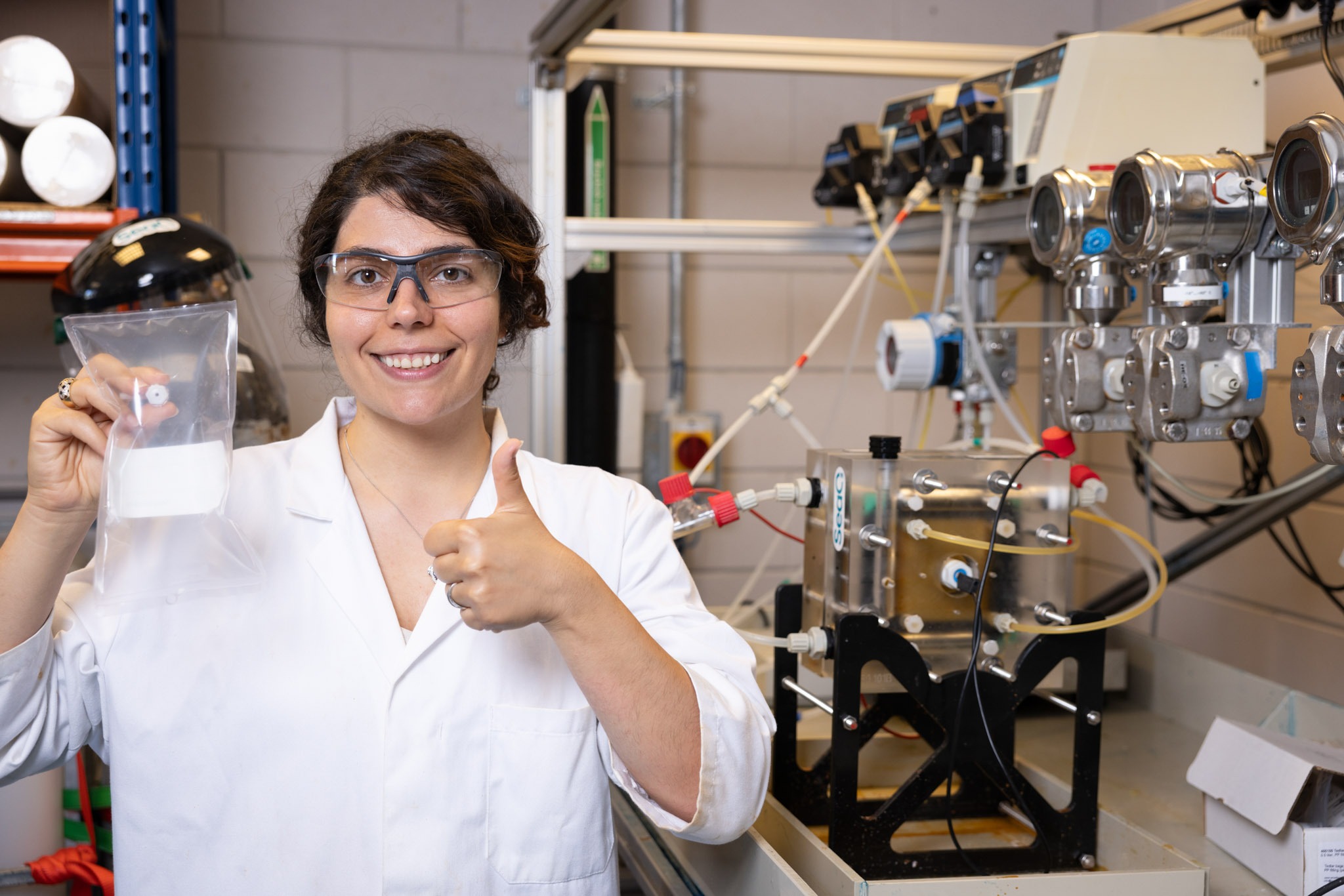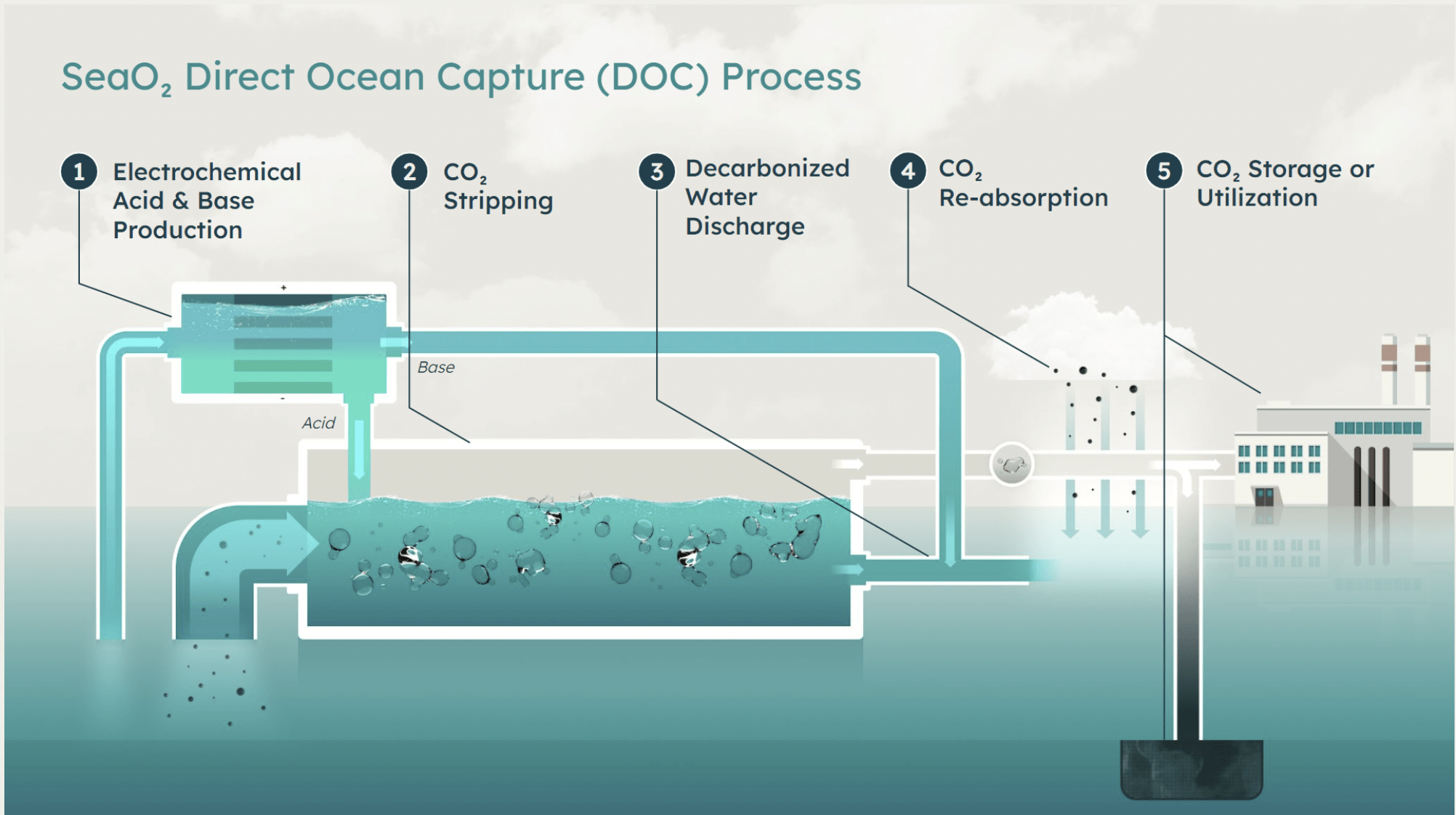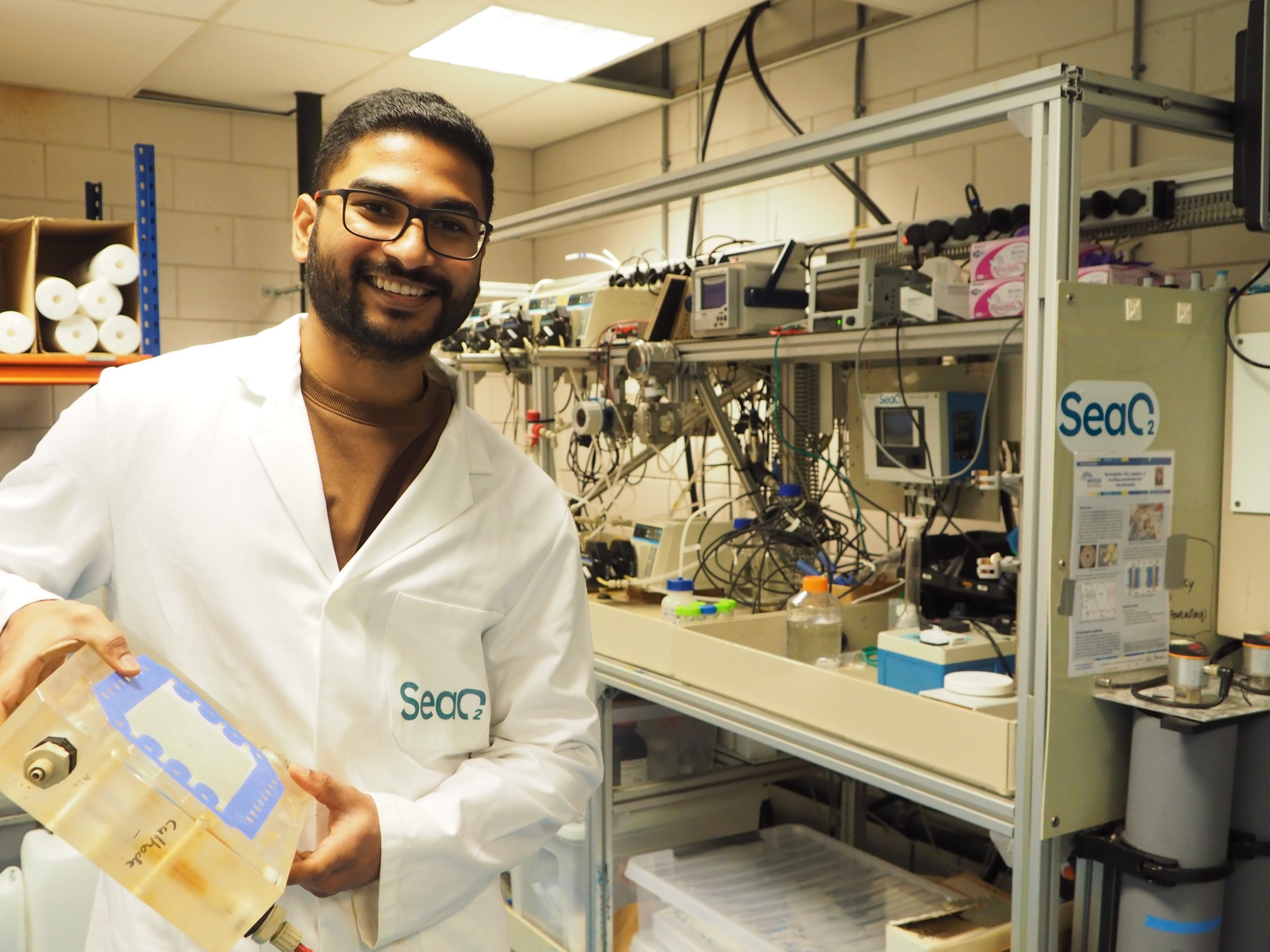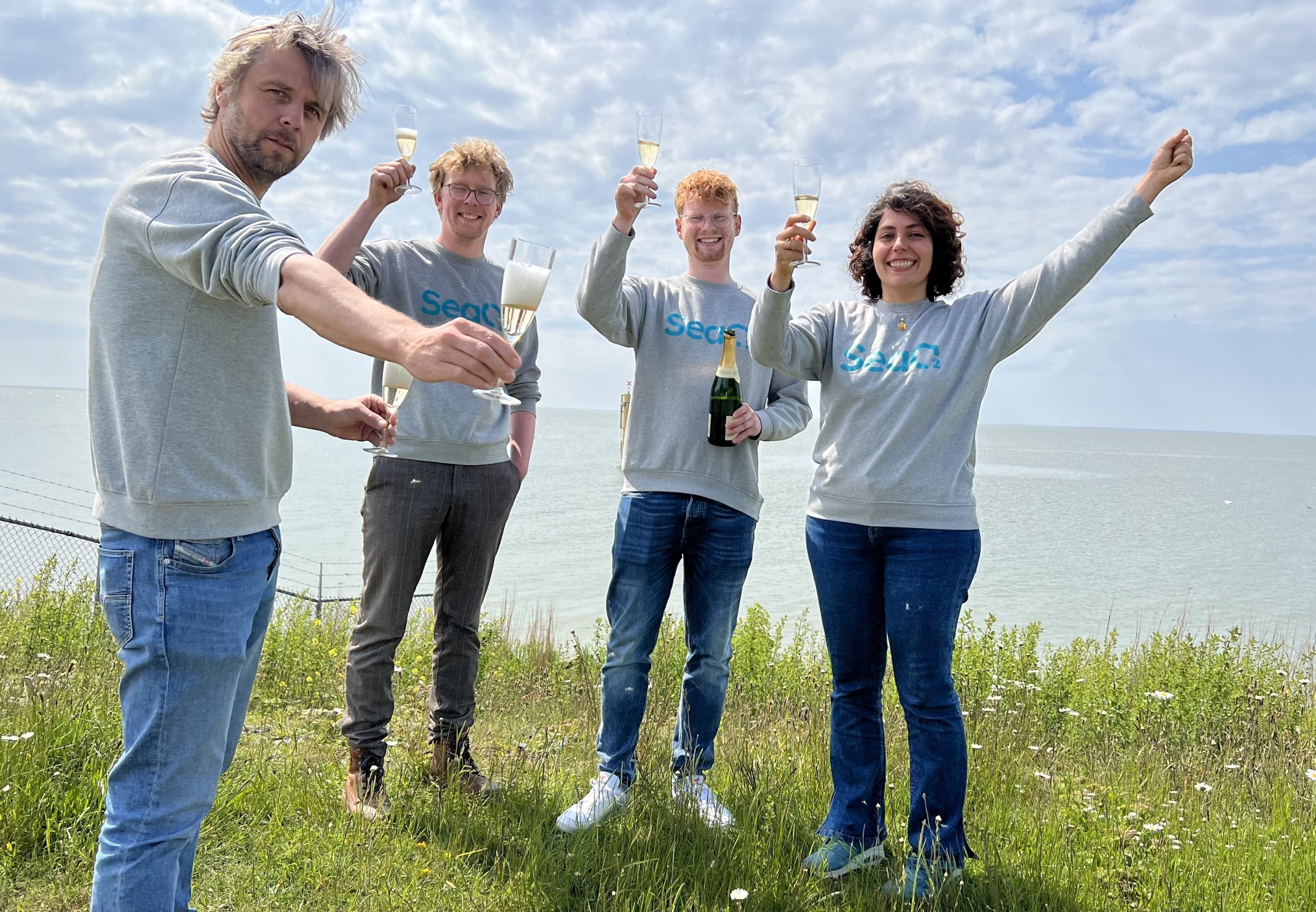Halfway along the Afsluitdijk stands the pilot factory of SeaO2, a start-up originating at TU Delft that extracts CO₂ from seawater to slow down climate change. A task as essential as it is challenging.
Champagne on the Afsluitdijk to celebrate the first amount of CO₂ from seawater. (Photo: SeaO2)
‘CO₂ is humanity’s greatest threat’. That’s why Elon Musk offered USD 100 million through the XPRIZE for the best ideas to combat climate change and restore the CO₂ cycle. The TU Delft SeaO2 start-up is one of the 1,327 entries in the competition and one of the companies shortlisted as a ‘phase 1 top 60 team’. The company has offices in Amsterdam and Leeuwarden and is building a prototype in a warehouse on the Afsluitdijk.
The Intergovernmental Panel on Climate Change (IPCC) estimates that by 2050, 10 gigatons (10 billion tonnes) of CO₂ need to be removed from the atmosphere every year to keep the average temperature rise below two degrees Celsius. For comparison, current global emissions are four times higher: 40 billion tonnes per year. The XPRIZE organisation states, ‘It’s becoming clear that we need to remove gigatons of carbon dioxide to avoid the worst impacts of climate change.’
That goal remains distant. The current CO₂ capture capacity is about 0.1% of the amount emitted annually into the atmosphere.
Fun Facts CO₂
1 tonne of CO₂:
… is the emissions equivalent of two round-trip flights between Amsterdam and Barcelona. Or driving 9,000 kilometres in a car that consumes five litres per 100 kilometres.
Humanity produces 37 billion tonnes (37,000 Mt) of CO₂ annually. That’s an average of four tonnes per person. Americans lead at 16 tonnes per person.
CO₂ Capture:
The total capture capacity is currently 45 MtCO₂ per year, which is about 0.1% of global CO₂ emissions.
To keep global warming below two degrees Celsius, the capture capacity must reach four gigatons per year by 2030, which is 100 times more than today.
And 10 gigatons per year by 2050, which is more than 200 times the current capacity.
Energy for Capture:
According to a recent review, capturing CO₂ from the air (direct air capture) currently requires 2,000 to 3,000 kilowatt hours per tonne of CO₂. That’s the annual electricity usage of an average Dutch household.
Capturing 10 gigatons of CO₂ per year (the 2050 goal) would, at current technology levels (2,500 kWh/ton), require 15% of the world’s primary energy consumption (180,000 TWh/year). This does not include the CO₂ storage or processing.
Costs for Capture and Storage:
Depending on the technology, capturing CO₂ from the air with storage currently costs between USD 600 and USD 1,000 per tonne of CO₂. However, costs are expected to decrease to USD 250-300 per tonne by 2030, and eventually even to USD 100-200 per tonne.
Producers pay USD 70-100 per tonne of CO₂ on the European Emissions Trading System (ETS).
The gap between emission rights prices and capture costs means that CO₂ capture projects from air or water currently still rely on additional subsidies.
XPRIZE entries are divided into four categories. One category involves machines that remove CO₂ from the air (air solution). In another category, start-ups focus on accelerating natural erosion processes (rocks solution), where pulverised rock absorbs CO₂. Then, there are start-ups aiming to capture CO₂ by growing trees and storing it, and burying the wood (land solution) for example.
The TU Delft SeaO2 start-up belongs to the fourth category, ocean solutions. This solution sounds simple: the ocean absorbs CO₂ from the atmosphere, so if you remove CO₂ from seawater, it can absorb more. This will gradually reduce atmospheric CO₂ concentrations (and thus the greenhouse effect and climate change). A side benefit is that it also decreases ocean acidification.
Fizzing
Now for the practical side: how do you extract CO₂ from seawater? SeaO2 has developed a technology that makes the greenhouse gas bubble out of seawater, similar to how carbon dioxide fizzes in Coke when you drop a mint in it.
By applying an electric current across a membrane, a small portion (1%) of the seawater stream is separated into an acidic and an alkaline stream. By adding the acid further back in the rest of the seawater, the solubility of CO₂ drops significantly, causing the gas to fizz out. Doing this in a vacuum amplifies the process. The technology was patented by Rezvan (Rose) Sharifian and David Vermaas, among others, who co-founded SeaO2 with CEO Ruben Brands.

Sharifian earned her PhD in 2022 on Electrochemical Ocean Carbon Capture, with Dr David Vermaas as her co-supervisor and Prof. Chris Kleijn (Faculty of Applied Sciences) as her supervisor.
Sharifian initially studied petroleum engineering in Tehran and at TU Delft but decided to switch to ‘the green side’ after graduation. She applied for a PhD project at TU Delft and Wetsus, the water research institute in Leeuwarden, to capture CO₂ from seawater. “Seawater contains over 140 times more CO₂ than air,” she explains in an interview (in Dutch) in De Ingenieur. “We can change the water’s pH using an electrochemical machine, causing all the carbonates and bicarbonates dissolved in the seawater to release CO₂ in gas form.”

Ambitions
The lab setup could remove one tonne of CO₂ from seawater in a continuous process lasting one year. The aim is to scale up the capacity at the Afsluitdijk facility from 25 tonnes of CO₂ per year to 250 tonnes per year.

“The phase one pilot plant of 25 tonnes of CO₂ per year fits in a shipping container,” explains Asvin Sajeev, the Chemical Process Engineer at SeaO2. “The next step of 250 tonnes of CO₂ per year will probably fit into four containers since we can use the same pumps.”
“And we have the advantage of not using any chemicals at all,” says Ruben Brands, CEO of SeaO2. This sets the company apart from others, such as the Canadian competitor Planetary, which aims to treat seawater with acid inhibitors. Direct competitors include Captura from California, which extracts CO₂ from seawater using a membrane filter, and Ebb Carbon, which raises seawater’s pH (making it more alkaline) using an electrochemical process.

Brands notes that the phase two pilot (250 tonnes/year) is scheduled for next autumn (Q3 2025). And that’s just the beginning. In fact, it’s merely the starting point. SeaO2’s ambitions align with the global goal of 10 gigatons of CO₂ per year by 2050. The aim is to increase capacity by a factor of 10 each year, with targets set at one megaton by 2030 and one gigaton (billion tonnes) by 2045. That would represent a 10% share in the global target for 2050.
Scaling up is costly and requires significant subsidies and investments. Millions of dollars from Elon Musk’s XPRIZE would greatly expedite this expansion. Whether SeaO2 will secure this funding will become clear next February, four years after the launch of the XPRIZE carbon removal initiative.
- Also read: XPRIZE – USD 100 m prize for carbon removal
- Check current vacancies on the SeaO2 website
Do you have a question or comment about this article?
j.w.wassink@tudelft.nl


Comments are closed.